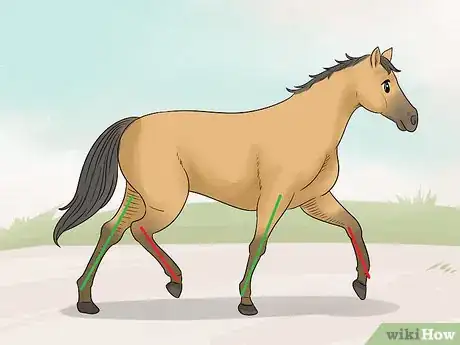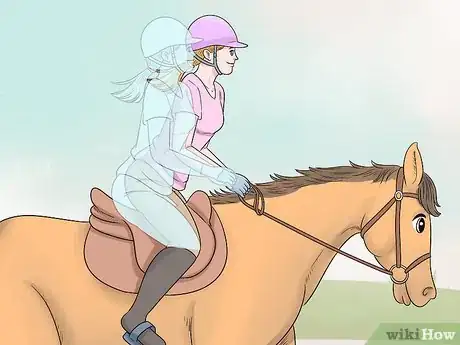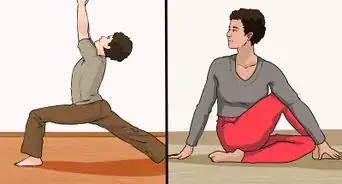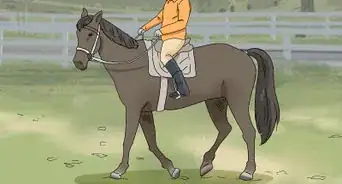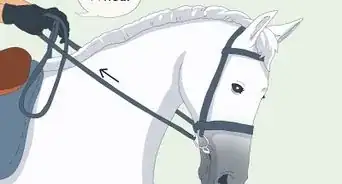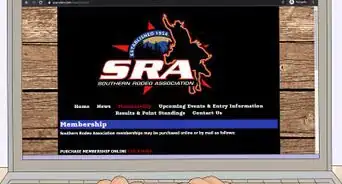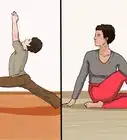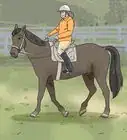wikiHow is a “wiki,” similar to Wikipedia, which means that many of our articles are co-written by multiple authors. To create this article, 47 people, some anonymous, worked to edit and improve it over time.
wikiHow marks an article as reader-approved once it receives enough positive feedback. This article received 13 testimonials and 96% of readers who voted found it helpful, earning it our reader-approved status.
This article has been viewed 253,837 times.
Learn more...
Posting (also known as the rising trot) is a riding technique used primarily in English-style horse riding, whereby the rider rises from the saddle in time with the horse's gait. This prevents the rider from being jostled around during the trot and from putting pressure on the horse's back. Although it may feel unnatural at first, the rising trot becomes much easier with practice and becomes even easier than sitting the trot. Start with Step 1 below to learn how to post correctly.
Steps
Learning to Post
-
1Understand why posting is done. The main reason to post while riding is to avoid being jostled around in the saddle during a particularly bumpy gait - the trot. This makes things more comfortable for the rider and is easier on the horse's back.[1]
- Once you become more experienced with the rising trot, it is also possible to change the horse's rhythm simply by posting more quickly or slowly.
- The horse will alter his rhythm to match with your own, thus sometimes eliminating the need for hand and leg signals.
-
2Understand diagonals. Urge your horse into a steady forward trot. Now, pay attention to the horse's strides - notice how the trot has two beats? Good. This will help you to understand how posting works.[2]
- During a trot, the horse's left hind leg and right front leg (which are diagonal to one another) move simultaneously, and vice versa. This is what riders are talking about when they refer to "diagonals" - the simultaneous movement of diagonal front and back legs.
- These diagonals will greatly influence your rising trot. When performed correctly, the rider will rise from his/her seat when the inside hind leg and outside front leg are moving forward and sit when the outside hind leg and inside front leg are moving forward.
- The reason for this is because the horse's inside hind leg is the one which propels him forward. Rising out of your seat while this leg is in motion will encourage the horse to stretch the leg further under his body, and therefore producing a more effective stride.
- At first, it can be difficult to tell which diagonal your horse is on. A good trick is to watch your horse's outside shoulder. You should rise out of your seat as his shoulder moves forward and sit back down as it moves back.
- If the movement is difficult to pinpoint, stick a bandage or piece of colored tape on the horse's shoulder. This makes the movement easier to see.
Advertisement -
3Realize that posting should be done using your thigh muscles, not your legs. Once you start posting your legs will likely be sore, but you'll gain more thigh muscles over time.
Posting
-
1Gather the reins so you're in contact with the horse's mouth. Don't pull back, rather act like your elbows are removed from your moving body and you're holding the horse's hand (or, rather, his mouth).
-
2Post forward and up simultaneously, then down and back. As you rise your pelvis should go forward and up, gliding up into the space between your hands without any interruptions. Your back should be straight, with your chest up and your shoulders back. As you go down, sit softly into the saddle only for enough time as takes to rise again. The entire movement of posting should be very upward based, and when your seat touches the saddle it should be done very lightly, and immediately be proceeded by rising again.[3]
- Firstly, sitting straight up and down takes too long and will cause you to lose your rhythm. Secondly, standing up straight in the stirrups will cause your legs to involuntarily shoot forward, throwing you off balance. And thirdly, rising straight up will cause you to land heavily in the saddle, which puts pressure on the horses back and defeats the purpose of posting in the first place.
- Instead, you should try to move forwards and backwards while rising, as this is a much more organic movement. When your horse's outer front leg goes forward, move your pelvis forwards towards the top of the pommel. You should only rise an inch or two out of your seat - just enough to clear the saddle.
- Don't use your feet to propel yourself - in fact, your legs don't come into the equation at all! Point your knees towards the ground, then squeeze your inner thigh muscles to lift your pelvis out of the saddle.
- As you rise out of your seat, lean forwards at a 30 degree angle. This helps you to move more naturally with the horse, allowing him to trot better. The one exception to this is in dressage, where the shoulders stay straight, in line with the hips.
- As the horse's outside shoulder move back, sit down softly into the saddle.[4]
-
3Change your diagonal when you change rein. When you change rein (that is, change direction when riding in an arena), your horse's inner hind leg and outer front leg will switch diagonals, which means you will have to change your posting rhythm.[5]
- To change diagonals, remain seated for one extra stride, so when you rise from your seat it will be in sync with the forward motion of your horse's (new) inner hind leg and outer front leg.
- In other words, instead of doing up - down - up - down you will do up - down - down - up. It sounds complicated, but it's easy once you get the hang of it.
- You don't need to worry about changing diagonals when you're out on a hack, as the horse has no "inner" or "outer" legs outside of the arena. However, this gives you a good opportunity to practice posting and changing diagonals, as you can decide to switch sides as often as you like.
Troubleshooting Common Problems
-
1Avoid sitting too heavily. Sitting down too heavily is a major problem for riders new to the rising trot. It puts pressure on the horses back, causing him to shorten his stride and possible throwing him off balance.[6]
- As long as you are posting by moving forwards and backwards instead of straight up and down, you should be able to avoid a very heavy landing.
- However, stiffness can also be an issue, so make sure to soften your knees and try to move naturally with the horse.
-
2Ensure your legs are positioned correctly. If your legs are two far forwards, you will end up leaning backwards and if your legs are too far back, you will end up leaning forward - neither of which are ideal for the posting trot.[7]
- Try to keep your legs at the girth ( the middle of the horse) as this will ensure your back stays in the correct position.
- You should also try to avoid making involuntary leg movements (which are common while posting) as this can give the horse mixed signals, as he thinks you are kicking him or urging him forwards.
- These involuntary movements usually occur when your lower legs are too loose, but your knees and thighs are too tight. You can combat this by relaxing your upper legs and tightening your lower legs, keeping your calves pressed lightly against your horse's barrel at all times.[8]
-
3Keep your eyes up. Many riders become so absorbed with matching their rising movement to the horse's gait that they spend the whole time staring at the horse's shoulders and forget to keep track of their surroundings.[9]
- This is an easy habit to get into, but a hard one to break. Not only are you less aware of what's going on around you, you will also be inclined to slump your shoulders forward which affects your posture and ability to post.
- Get out of this habit by picking a point to look at while you post, whether it's the top of the trees or a nearby roof. This will also help you to learn how to time your rising trot correctly through feel alone, rather than by sight.
-
4Keep your hands and arms steady. Many riders have a tendency to bounce their hands and arms up and down as they post. This is incorrect, as it disrupts your contact with the horse and confuses your aiding system.[10]
- Try to keep your hands and arms steady, keeping them in the exact same position, even as the rest of your body moves forwards and backwards.
- If it helps, imagine your hips moving between your elbows as you rise.[8]
Community Q&A
-
QuestionMy trainer has recently had me posting without the stirrups in order to build leg muscles, but it gets tiring fast. Any advice on how to build up certain muscle so it gets easier?
 Community AnswerGet one of those big yoga balls, squeeze it between your legs, and imitate the posting movement. It looks really weird, but it definitely builds up the muscles that you need!
Community AnswerGet one of those big yoga balls, squeeze it between your legs, and imitate the posting movement. It looks really weird, but it definitely builds up the muscles that you need! -
QuestionIf my foot is too far in the stirrup while I'm posting, I can't bring it out without putting it further in. Any tips on adjusting?
 Community AnswerMake sure that your knees are bent and your legs are back. If you bring your lower leg forward, your stirrup will slowly slip farther back.
Community AnswerMake sure that your knees are bent and your legs are back. If you bring your lower leg forward, your stirrup will slowly slip farther back. -
QuestionHow do I keep my ankles and hands down in the stirrups when posting?
 Community AnswerPoint your toes up. A good exercise is to put spurs on your toes and not let them fall off when you ride. It's difficult but it works.
Community AnswerPoint your toes up. A good exercise is to put spurs on your toes and not let them fall off when you ride. It's difficult but it works.
Warnings
- Posting high or too fast can cause your horse to speed up. But, when a horse is being lazy, don't use this to speed him up. That will teach him that is okay to be lazy.⧼thumbs_response⧽
- Learn to check your "diagonal" discreetly and don't look down too long. You can lose your balance very easily and it will affect your rhythm and quality of trot. Also, if you're horse showing, obviously looking down will be penalized. Eventually you should be able to feel the diagonal without looking down at all.⧼thumbs_response⧽
Things You'll Need
- Helmet
- Riding Boots
- Horse
- Instructor
- Gloves too if you can get them (prevents your hands from losing contact - or getting blisters - with your reins if you're a beginner)
- Saddle
- Bridle and reins
References
- ↑ https://www.equisearch.com/articles/ups-and-downs-posting
- ↑ https://www.youtube.com/watch?v=thpmgolDsbQ&feature=emb_logo
- ↑ https://www.youtube.com/watch?v=thpmgolDsbQ
- ↑ http://en.wikipedia.org/wiki/Trot
- ↑ https://practicalhorsemanmag.com/training/change_posting_trot_diagonal_071910
- ↑ https://practicalhorsemanmag.com/training/exercises-to-correct-common-riding-problems
- ↑ https://practicalhorsemanmag.com/training/exercises-to-correct-common-riding-problems
- ↑ 8.08.1http://www.horsechannel.com/english-horse-training/horse-posting-trot-9753.aspx
- ↑ https://practicalhorsemanmag.com/training/10-time-tested-rider-position-fixes
About This Article
To post while trotting on a horse, start by making sure your back is straight, chest lifted, and shoulders are back as you prepare to move yourself up out of the saddle. When you’re ready to post, use your inner thighs to squeeze yourself forward and up at the same time, then down and back in rhythm with the horse. As the horse’s outside front leg moves forward, rise up out of the saddle slightly, and when the same leg moves back, sit softly into the saddle again. To learn how to keep your hands and arms steady as you post, keep reading!

